Resources
2023 Physician Compensation Report

No matter where they practice or what their specialty is, physicians want and need to know how their salary compares to others.
The 2023 Physician Compensation Report Answers Questions About:
- Which physicians are highest-paid?
- Can moving to a new city or state increase your compensation?
- How does your specialty compare to other specialities and their compensation?
- Are there biases in compensation?
- Which are the highest-demand specialities?
- Which regions of the country are hiring the most?
- Where are physicians being offered the biggest bonuses?
We have saved you the trouble of spending countless hours sifting through expensive compensation reports that consist of hundreds of pages, as we have already done the hard work for you.
Our annual physician compensation report will save you time and money looking for the data and statistics you want to know.
HERE’S WHAT WE DETAIL IN THIS REPORT:
- How physicians in different medical specialties and regions of the United States are being compensated
- The gender wage gap
- How much physicians are earning in incentives
- Which specialties are in the greatest demand
We’ve compiled data from nearly a dozen different sources using current information to offer you the free Physicians Thrive 2023 Physician Compensation Report.
The Free Physicians Thrive 2023 Physician Compensation Report
Physicians’ salaries vary by region, specialty, gender, and a variety of other factors. From year to year, we see increases in certain regions, for certain specialties, and increasing bonuses in areas where there is a high demand for physicians.
We’ve broken down the compensation trends for physicians by specialty, region, gender, and by bonus incentives to provide insight into where salaries are increasing and where they’re decreasing.
Compensation by Region
Some of the same metro areas in the Northeast and South which have larger numbers of medical professionals and institutions, continue a trend of lower salaries.
Last year some lower-paying areas did increase pay, and now appear on the list of the top ten metro areas by percentage of pay increase. Rural areas also continue to pay some of the highest salaries in the country to attract medical professionals.
There are, however, some mid-sized metro areas that saw a salary increase. Buffalo and Boston saw significantly increased salaries. St. Louis, Virginia Beach, and Charlotte, NC all saw double-digit salary increases.
Metro areas with the biggest salary increases:
- Charlotte +12.9%
- Virginia Beach +12.1%
- St. Louis +10.5%
- Tampa +8.1%
- Hartford +7.8%
- Buffalo +7.4%
- Sacramento +7.1%
- Orlando +7.0%
- Nashville +6.9%
- Boston +6.1%
Metro areas that pay the highest salaries:
- Charlotte: $462,760
- St. Louis: $452,219
- Buffalo: $426,440
- Jacksonville: $425,706
- Orlando: $425,634
- Minneapolis: $425,059
- Milwaukee: $422,735
- Phoenix: $419,359
- Dallas: $415,487
- Los Angeles: $414,925
Metro areas that pay the lowest salaries:
Baltimore: $330,917
Providence: $346,092
San Antonio: $355,439
Washington DC: $356,633
Boston: $363,545
Portland: $363,890
Denver: $364,927
Philadelphia: $373,765
Birmingham: $375,074
Detroit: $376,007
Los Angeles is the biggest metro area to join the highest-paying list this year. On the lower end of salaries, several cities saw significant pay increases, like Detroit and San Antonio, which was at the bottom of the list on our 2022 report. All higher-paying metro areas are over $400,000 a year in salary.
Lower-paying metro areas tend to have older healthcare infrastructures and declining populations. However, there are a few exceptions, including Denver, which is a younger, growing city. Eastern seaboard cities and some Southern cities continue to pay lower salaries and are losing population in favor of higher pay and improved housing costs in growing mid-sized cities in Florida, some parts of Texas, and the Midwest.

Indicates states that are new to the top ten for 2023.
Oregon, North Carolina, Connecticut, and Texas join the Top Ten highest median salary states for 2023. Iowa, South Carolina, Oklahoma, and Georgia are no longer in the Top Ten.
For physicians in four high-paying specialties, median salaries vary significantly, depending on the region in which they work:
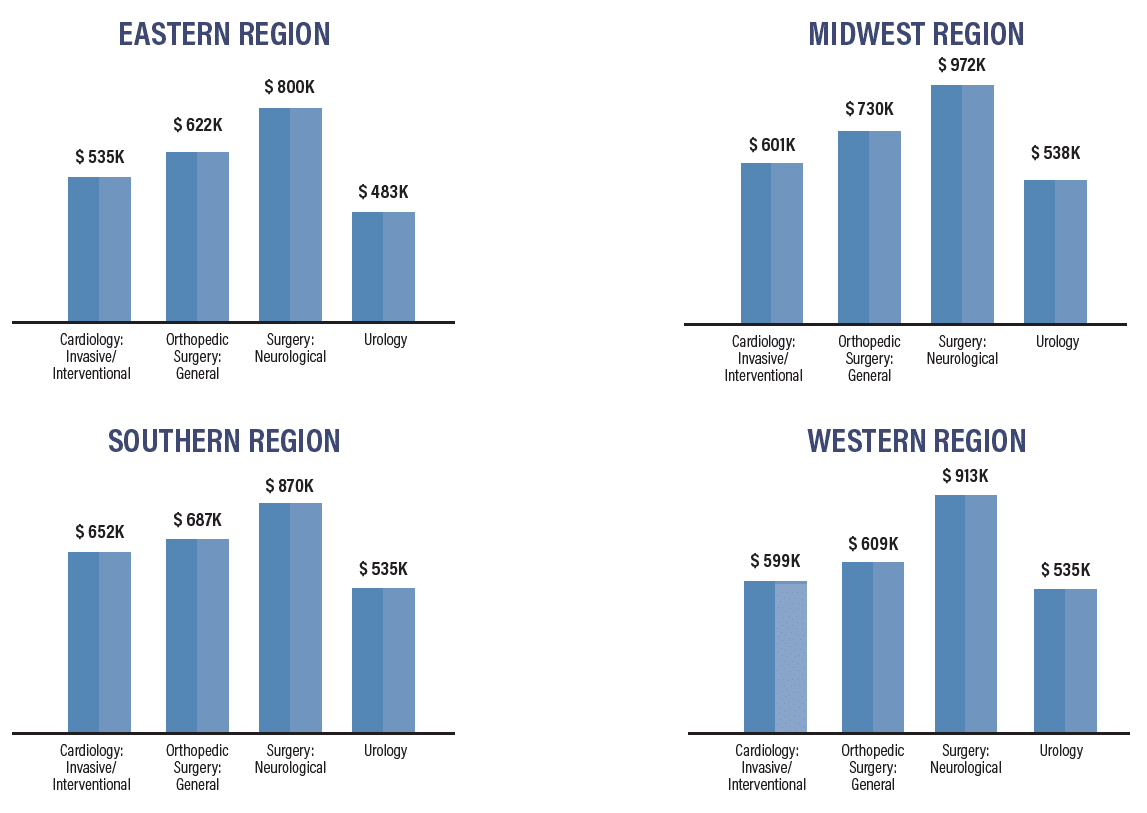
Median salaries in these specialties are beginning to show significant variations between specialty and regionally. However, East coast salaries continue to be lower on average than those in other regions.
There are a variety of reasons for this variation in pay, and higher concentrations of qualified physicians in the Eastern region continue to be a significant influence on median annual earnings for many specialties.
Compensation by Specialty
PCPs earned an average of $251k in 2022, a 3% increase over 2021—the highest historical average recorded to date. Grouped together, specialists earned an average of $351k in 2022, up from $344k in 2021.
Surgical specialists continue to be among some of the highest-paid professionals in medicine. Pediatricians and those who practice family medicine continue to be among the lowest-paid physicians.
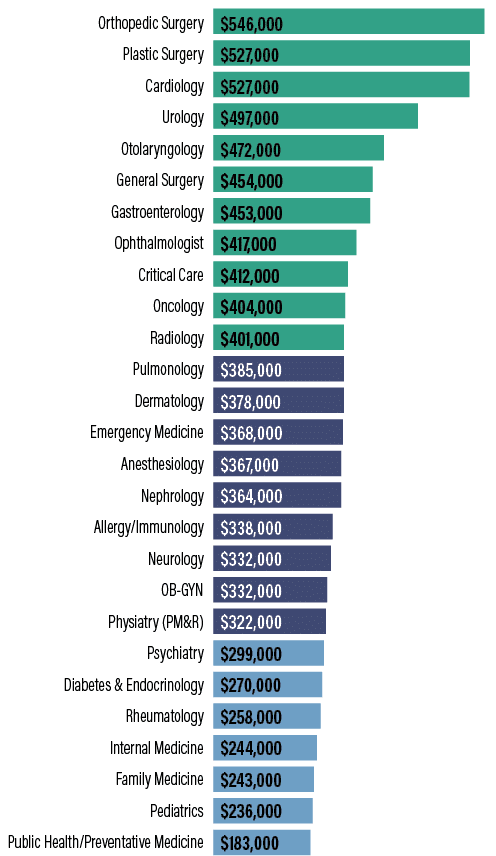
Specialties with the biggest salary increases:
Ob/GYN +14%
Radiology +12%
Anesthesiology +8%
Cardiology +8%
Neurology +7%
Specialties with the biggest salary decreases:
Cardiology (Inv) -16%
Dermatology -3%
Pediatrics -3%
Nonsurgical specialists-1%
Surgical physicians-1%
Plastic surgeons, cardiologists and orthopedic surgeons remain among the highest-earning specialties with an average compensation over $500,000.
Compensation by Gender
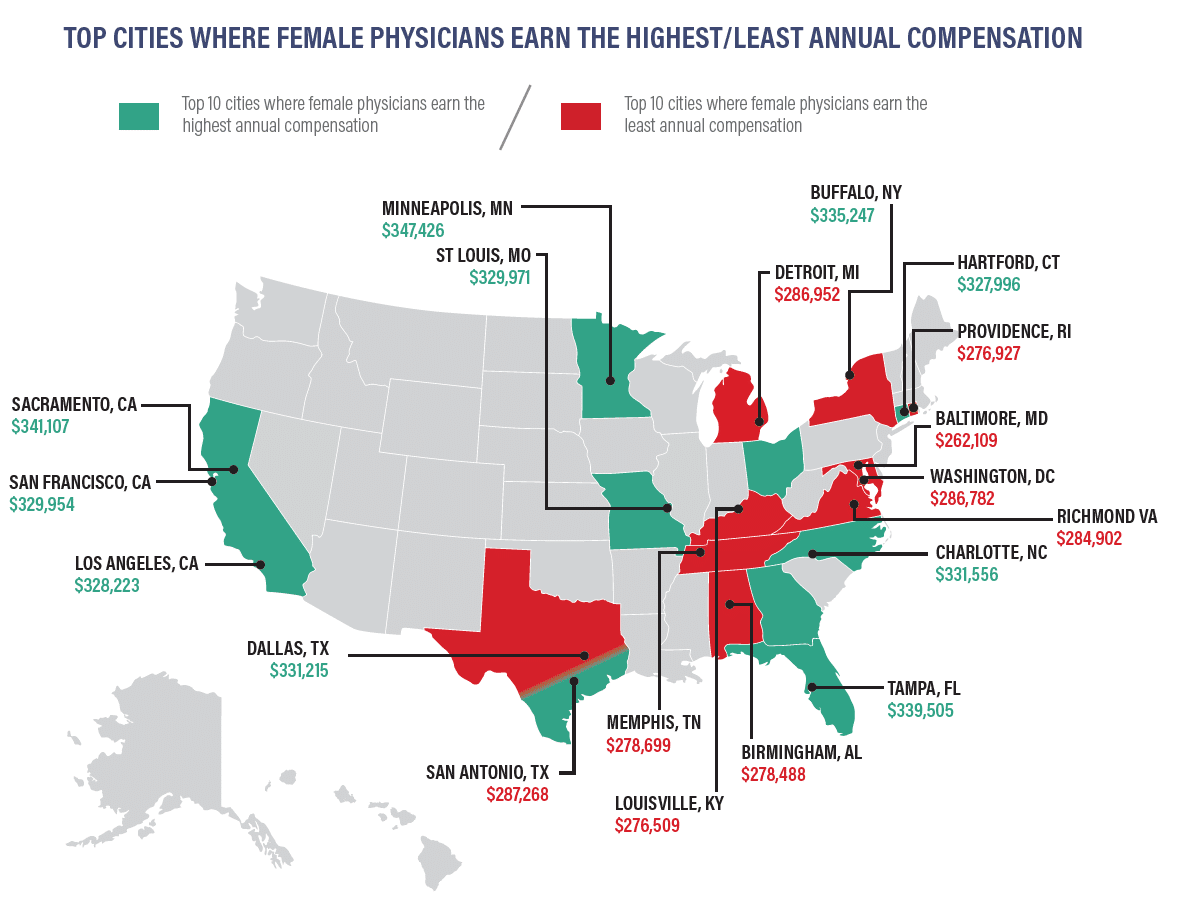
The pay gap between female and male physicians in the United States continued in 2022.
The overall gender pay gap between male and female physicians is significant. Current data shows that on average, male doctors earn $122,000 a year more than female counterparts. Analyzing the five medical specialties with the largest pay gaps between male and female practitioners, male specialists earned an average of $477,484 as compared to females in the same five specialties, who earned an average of $377,732, a difference of over 20%.
Pay does vary depending on location, so where do women earn the most and earn the least? Hartford, CT appeared on the lowest-paying list in 2021 and rose to the highest-paying in 2022.
Where is the gender wage the most prevalent?
Our findings illustrate that the gender pay gap varies considerably based on region and specialty.
Specialties with the largest gender wage gaps:
- Oral/Maxiollofacial Surgery: women earn 22.8% less
- Allergy & Immunology: women earn 21.1% less
- Otolaryngology: women earn 20.1% less
- Pediatric Nephrology: women earn 20% less
- Thoracic Surgery: women earn 19.5% less
Specialties with the smallest gender wage gaps:
- Pediatric Rheumatology: women earn 7.8% less
- Pediatric Infectious Disease: women earn 10.1% less
- Pediatric Hematology/Oncology: women earn 11.3% less
- Hematology: women earn 12.1% less
- Pediatric Cardiology: women earn 12.5% less
Top 10 Cities Where Female Physician Earn the Highest Annual Compensation
- Minneapolis: $347,426
- Sacramento: $3414107
- Tampa: 339,505
- Buffalo: $335,247
- Charlotte: $331,556
- Dallas: $331,215
- San Francisco: $329,954
- St. Louis: $329,971
- Los Angeles: $328,223
- Hartford: $327,996
Bottom 9 cities Where Female Physicians Earn the Least Annual Compensation
- San Antonio: $287,268
- Detroit: $386,952
- Washington, DC: $286,782
- Richmond: $284,902
- Memphis: $278,699
- Brimingham: $278,488
- Providence: $276,927
- Louisville: $276,509
- Baltimore: $262,109
Related: How Female Physicians can Counteract the Gender Pay Gap
Compensation Bonuses
Physicians in both primary care and specialties continue to earn bonuses, and after a decline in 2021, RVU-based bonuses once again represent a major source of bonuses for physicians.
Bonuses for Quality of Care increased from 23% to 58% between 2021 and 2022.
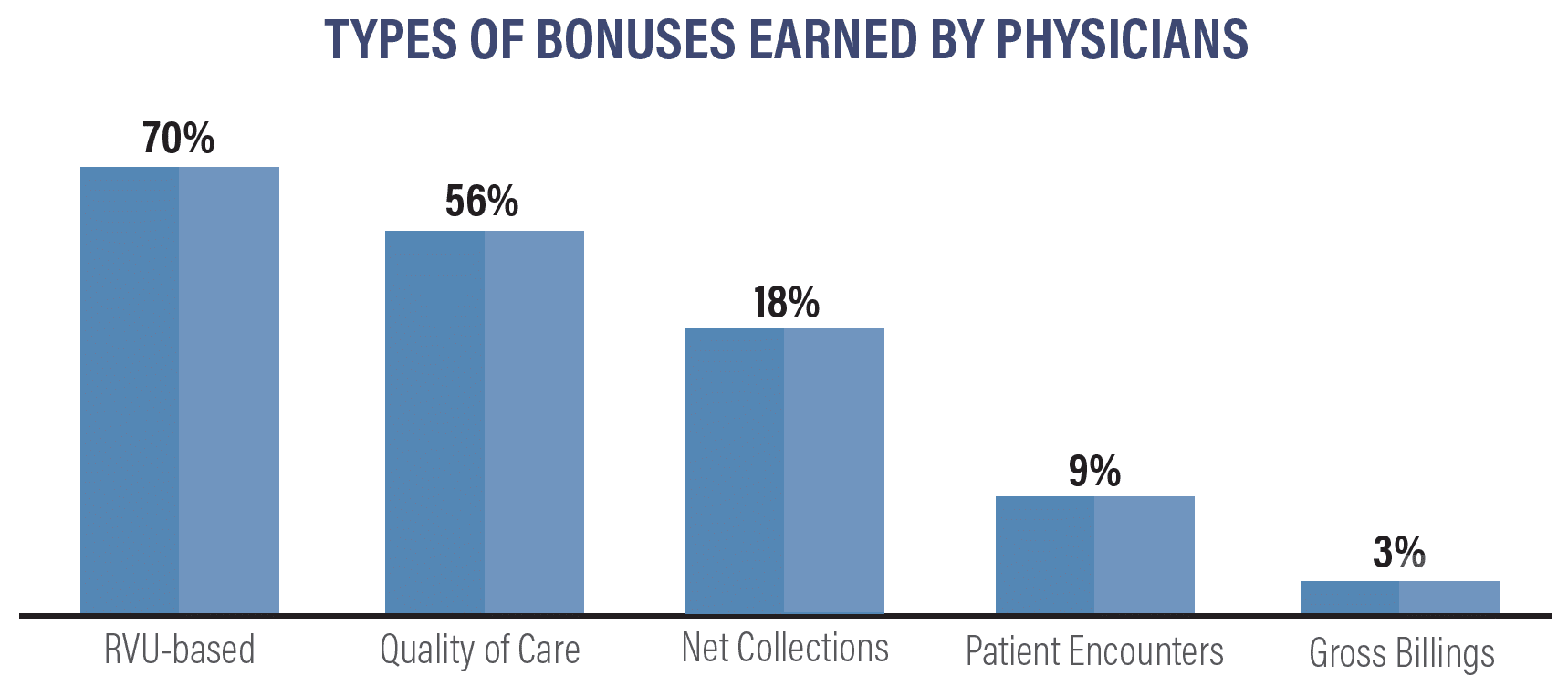
In 2022, here’s how bonuses compared to the previous year:
- RVU-based: 70% (up from 57% last year)
- Quality of Care: 26% (up from 23% last year)
- Net Collections: 18% (down from 23% last year)
- Patient encounters: 9% (down from 10% last year)
- Gross Billings: 3% (up from 2% last year)
Top 17 Average Incentive Bonuses by Specialty:
- Orthopedics/Orthopedic surgery: $126k
- Ophthalmology: $100k
- Cardiology: $85k
- Gastroenterology: $74k
- Urology: $73k
- Anesthesiology: $68k
- Radiology: $66k
- Pathology: $54k
- Emergency Medicine: $54k
- OB/GYN: $49k
- Physical Med/Rehab: $48k
- General Surgery: $46k
- Psychiatry: $33k
- Family Medicine: $30k
- Internal Medicine: $29k
- Neurology: $29k
- Pediatrics: $28k
For the first time in the past decade, every specialty reported receiving some form of incentive bonus. On an individual basis, 57% of specialists reported earning an incentive bonus in 2022. Amongst PCPs, 54% received an average incentive bonus of $33.5k.
Related: When Physicians Should Walk Away From a Job Offer
Compensation Trends Summary
Here are some key takeaways:
- Primary care physicians earned an average of $260,000 in 2022, up from $242,000 in 2021.
- Specialists earned an average of $368,000 in 2022, up from $344,000 in 2021.
- Depending on the specialty, physicians in the West and Midwest earn the highest salaries; however, for most specialties and PCPs, salaries in the East are the lowest.
- Plastic surgery and orthopedics #1 and #2 on annual compensation surverys, each earning over $500,000 per year, closely followed by cardiology, averaging $490,000 per year
- The biggest salary increases in 2022 were otolaryngology (up 13%), gastroenterology (up 12%), and dermatology (up 11%).
- Pediatrics is among the lower-paid specialties, but saw a 10% increase in pay on average in 2022. Ophthalmology and plastic surgery saw 10% salary increases as well.
- The biggest salary decreases are in cardiology and dermatology.
- On average, female physicians earn 23.6% less than male physicians in the same specialty.
- 57% of specialists earned an incentive bonus.
- 54% of PCPs earned an incentive bonus.
Hiring Trends
Hiring trends can change rapidly depending on regional and local needs. Rapid change in the healthcare system also creates demand for different specialties in different regions.
We use data from medical recruiting firms and annual surveys to create a breakdown of hiring trends based on specialty, region and medical setting.
Hiring Trends by Specialty
Between 2007 and 2019, family physicians were the most heavily recruited physicians around the country. In 2022, Nurse Practitioners became the most-requested hiring category. The COVID-19 pandemic and changing demographics are giving rise to the third consecutive year that specialists were the most-requested and recruited hiring category.
Top 10 Most Recruited Physicians:
- Gastroenterologists
- Radiologists
- Rheumatologists
- Hematologist/Oncologists
- Urologists
- Cardiologists
- Pulmonary/Critical Care
- Psychiatrists
- OB/GYNs
- Neurologists
There are five specialties which generate up to seven times their salary for average net annual hospital revenue: cardiology, orthopedic surgery, gastroenterology, family medicine, and OB/GYN.
Continued focus on mental health and post-pandemic stress saw psychiatrists remaining on the most in-demand list.
The physician shortage is ongoing and is expected to continue for the next decade.
Projected deficit of physicians through 2034:
- Primary Care: 17,800-48,000
- Medical Specialists: 16,8080
- Surgery: 13,900
- Other (including NPs): 26,400
- Hospitalists: 1,900
The physician shortage continues, along with shortages in specific specialties and allied practitioners.
By 2034, the overall shortage of physicians in the United States could reach 124,000. Of that, approximately 48,000 are primary care physicians and 76,000 will be specialists, ssurgeons, or hospitalists.
Hiring Trends by Region
The Eastern region and most large metro areas throughout the nation have the greatest number of trained physicians. Midwestern and Southern states, along with rural areas, are confronting large aging populations and have a greater shortage of trained practitioners. Hiring surveys show that areas with a shortage of physicians continue to offer higher salaries and larger bonuses to attract qualified candidates.
Shifts in care models are also affecting recruitment and hiring, including an increase in academic medical center recruitment and a move toward convenient care and telemedicine. Here’s how recruitment trends have changed, based on employment setting, over the past year:
- Hospital recruitment: 34% in 2022 (up from 33% in 2021)
- Medical group recruitment: 18% in 2022 (down from 29% in 2021)
- Academic medical center recruitment: 34% in 2022 (up from 20% in 2021)
- Federally qualified health center recruitment: 8% in 2022 (unchanged from 8% in 2021)
- Physician recruitment for solo, partnership, and concierge practices: 31% in 2022 (down from 3% in 2021)
Regardless of specialty, some employment settings offer higher salaries than others. Here’s how the average salary varies by employment setting for some of the top-earning specialties:
Orthopedic Surgery (General)
- Single specialty: $650k
- Multi-specialty: $663k
- Rural Health Clinic: $603k
- FHospital Department Practice: $675k
- Academic Department: $400k
Cardiology (Invasive-Interventional)
- Single specialty: $627k
- Multi-specialty: $601k
- Rural Health Clinic:$656k
- Hospital Department Practice: $626k
- Academic Department: $425k
Urology
- Single specialty: $525k
- Multi-specialty: $521k
- Rural Health Clinic:$475k
- Hospital Department Practice: $506k
- Academic Department: $400k
The biggest factors causing physician shortages:
- An aging population: the number of people 65 and older is expected to grow by 42% between now and 2034.
- Retirements: more than two out of five current physicians will be over age 65 between now and 2034.
- Burnout, stress, and COVID-19 effects are also expected to have an impact on physician shortages.
- Regional and geographic impacts are expected to continue in areas with more aging adults (Midwest and South).
- Telehealth and convenient care are influencing hiring trends and work conditions.
In 2021, some recruits did not receive relocation benefits that were standard before the pandemic, but some benefits were restored in 2022, along with decreases in most benefit packages.
In 2020/2021, 74% of new offers included relocation expenses, increasing to 78% in 2021/2022.
CME offers remained relatively stable, with 92% of new offers receiving CME payments this year, down from 94% last year.
Other benefits are down across the board for new hires:
- Health insurance: 68% (down from 78% last year)
- Malpractice: 66% (down from 78% last year)
- Retirement/401k: 61% (down from 68% last year)
- Disability: 61% (down from 70% last year)
- Educational Forgiveness: 16% (down from 21% last year)
Hiring Trends Summary
Here are the key takeaways:
- We are continuting to see a shortage of physicians, particularly in the Midwest and Southern regions. This is not expected to change.
- Demand for physicians is expected to increase, some specialties more than others.
- Underserved and Rural areas pay the highest salaries as well as the biggest bonuses.
- Family Physicians, which used to be in the highest demans, have not been the most recruited physicians since 2020.
Ongoing Impacts of COVID-19 and Other Trends
COVID-19 continues to impact the healthcare industry. Trends like telemedicine and “convenient care” affect work along with issues like burnout & stress.
Overall, salary trends for all physicians are up, including primary care physicians and specialists. However, among physicians who saw a decrease in income, 70% said that they continued to experience effects of the COVID-19 pandemic, including reductions in hours or job loss. 44% of physicians who lost income in 2022 credited another factor, including telehealth provided by insurance companies and convenient care at “minute clinics.”
Covid Effects in 2022:
As a result of COVID-19, in 2021, 72% of physicians reported a reduction in income, 43% had to work with reduced staff, and 8% closed their practices. By 2022, hiring had increased and long-term health challenges and the aging population drove rehiring and increased income:
- 15% experienced a reduction in income, down from 72% in 2021
- 8% have had to work with reduced staff
- 8% have had to close their practice; largely a result of retirement
The pandemic has taken a serious toll on physicians’ lives outside of work as well. Physicians report experiencing the following:
- Burnout: 58%
- Feelings of anger and/or anxiety: 50%
- Withdrawing from family and friends: 43%
- Sought medical attention for a mental health issue: 13%
Covid Continues to Affect Life Outside of Work:
Physicians report heavier workloads along with the following impacts:
- Burnout: 68%
- Feelings of anger and/or anxiety: 53%
- Withdrawing from family and friends: 35%
- Sought medical attention for a mental health issue: 17%
More than 38% of physicians surveyed have also expressed a desire to retire in the next year.
Would Physicians Choose the Same Specialty Again?
If given the chance to change careers, 73% of physicians said they would choose to work in medicine again. Of those, the majority of specialists are satisfied with their choice of specialty, although some are more satisfied than others.
Physicians Most Likely to Choose the Same Specialty Again:
- Dermatology: 99%
- Orthopedics: 97%
- Plastic Surgery: 96%
- Gastroenterology: 95%
- Infectious Disease: 94%
- Ophthalmology: 94%
- Radiology: 92%
- Urology: 90%
Physicians Least Likely to Choose the Same Specialty Again
- Pulmonary Medicine: 79%
- Public Health/Preventative Medicine: 79%
- OB/GYN: 76%
- Emergency Medicine: 74%
- Nephrology: 73%
- Family Medicine: 68%
- Internal Medicine: 63%
How Many Hours Are Physicians Working?
Physicians are working approximately the same number of hours now as they were prior to COVID-19, an average of 50 hours per week. Slightly more than 20% of physicians work 40 to 49 hours a week, about 25% work between 50 and 59 hours a week, and over 30% work more than 60 hours a week.
Time Spent on Patient Care versus Paperwork:
Physicians are spending an average of 15.48 hours per week on paperwork and administration. Different specialties are required to spend more time on paperwork than others.
Infectious disease specialists spend 19.8 hours a week on paperwork and administration, while anesthesiologists spend 10 hours a week.
Specialties like endocrinology, rheumatology, and OB/GYN average 15 hours per week on paperwork.
Are Physicians Happy?
Many physicians feel that their work is rewarding and their salary is fair. But how happy are physicians on the job?
Data shows that significant numbers of physicians don’t feel as though they are being fairly compensated and that they are dissatisfied with a variety of work conditions. However, the rewards of helping patients and discovering answers continue to provide happiness and satisfaction.
Aspects of the job that physicians find the most rewarding:
- Gratitude/relationships with patients: 27%
- Finding answers/making diagnoses: 25%
- Helping others: 23%
- Earning the salary: 12%
- Making good money at a job I like: 10%
- Being proud to be a physician: 5%
- Teaching: 5%
- Nothing: 3%
- Other: 2%
Aspects of the job that physicians like the least:
- Having so many rules and regulations: 23%
- Working long hours: 15%
- Difficult patients: 15%
- Difficulty getting reimbursement: 12%
- Working on an EHR system: 12%
- Other: 10%
- Worrying about being sued: 7%
- Danger/risk of treating COVID-19 patients: 3%
- Nothing: 3%
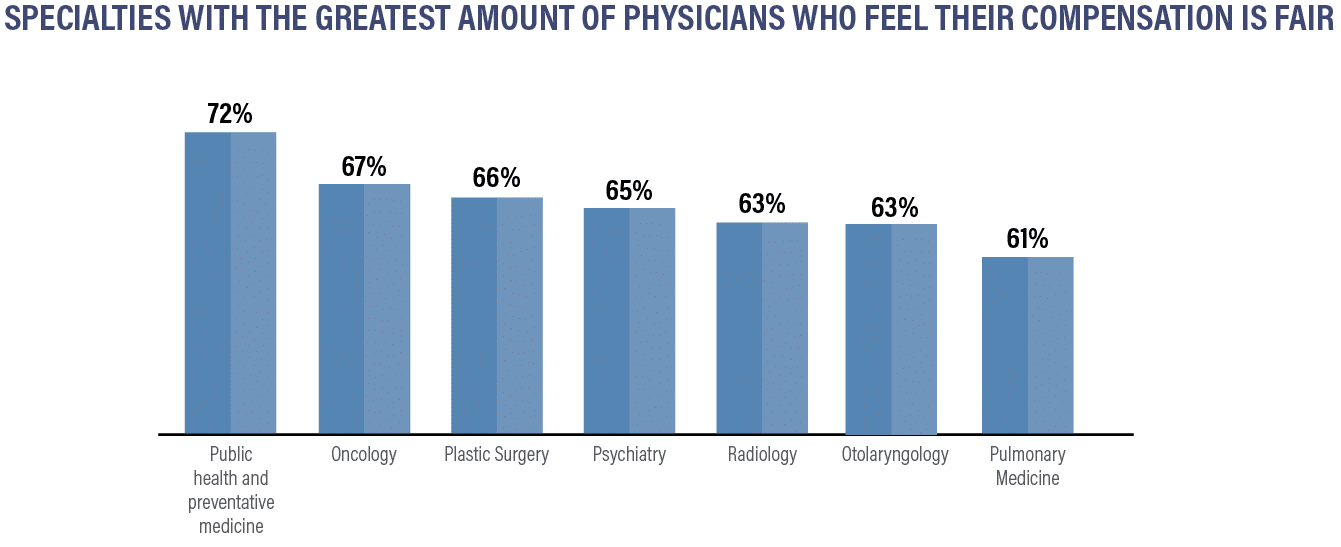
Specialties with the Greatest Amount of Physicians Who Feel Their Compensation is Fair:
- Public Health & Preventative Medicine: 72%
- Oncology: 67%
- Plastic Surgery: 66%
- Psychiatry: 65%
- Radiology: 63%
- Otolaryngology: 63%
- Pulmonary Medicine: 61%
Specialties Who Do NOT Believe They are Fairly Compensated:
- OB/GYN: 49%
- Internal Medicine: 49%
- Physical Med & Rehab: 49%
- Pediatrics: 47%
- Diabetes & Endocrinology: 46%
- Nephrology: 42%
Many physicians are satisfied with their work and compensation, but medicine is challenging and a number of physicians are experiencing burnout and stress.
Physicians continue to work long hours, and industry change is ongoing. Many physicians are asked to work with difficult-to-use and time-consuming EHR systems and cope with staff shortages. Physicians can discover their options and work with professionals to obtain the compensation they want and sign contracts that can improve their job satisfaction.
About to sign a physician contract for the first time? Conducting a job search in a new state? Wondering how your incentives and bonuses stack up against other physicians in your specialty or others?
This report shows the current landscape of compensation and hiring trends to help physicians gather industry data and analyze their potential, no matter where they are in their careers.
Figures provided are averages and can change. To understand your market value for your specialty and region, talk with one of our expert contract review specialists. We can help you negotiate the compensation you deserve.
To hire a contract review specialist, discuss financial planning for retirement, find creative tax-saving solutions, or protect your finances with disability insurance or life insurance, contact Physicians Thrive now.
SOURCES FOR THIS REPORT INCLUDE:
- Bureau of Labor Statistics Occupational Outlook Handbook
- Doximity 2021 Physician Compensation Report
- Salary.com
- Merrit Hawkins 2022 Review of Physician and Advanced Practitioner Recruiting Incentives
- Medscape 2022 Compensation Overview
- The Complexities of Physician Supply and Demand: Projections from 2019 to 2034 (AAMC)
- HRSA: Health Workforce Shortage Areas
- Changes in Buronout and Satisfaction with Work-Life Integration in Physicians During the First Covid-19 Pandemic
Request a Compensation Review
Unlock the power of tailored insights for your medical practice. Our Physician Compensation Review offers a deep dive into your compensation package, providing customized data specific to your specialty, practice type, and regional location within the U.S.
What’s Included:
– Personalized Compensation Analysis
– Specialty-Specific Data
– Regional Benchmarking
– Practice Type Insights
– Comprehensive Report
Ready for the Full Picture? Upgrade Option:
Should you decide to proceed with a comprehensive legal review of your contract, the cost of your Compensation Review can be seamlessly applied to the Full Contract Review.






































